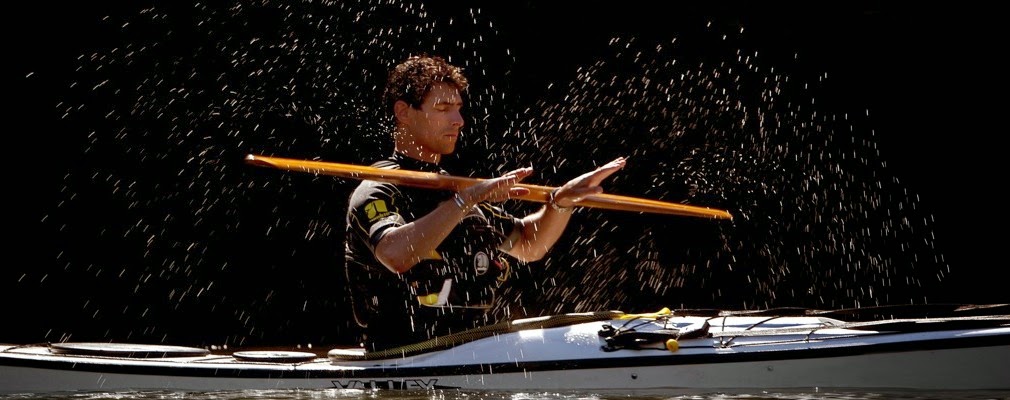 |
| Thanks to Kelly Adventure Centre for the pool. photo © Felicity Bell |
Most of what you're told about it is smoke and mirrors.
When I learnt to roll, it was from a book. I was twelve. I read the page about rolling over and over again, and I didn't really understand, but went out to try it anyway, all alone on a freezing November sea. Which I don't recommend, frankly. After a few attempts I was exhausted from swimming and emptying my boat. But I persevered, day after day, and you know what? I got absolutely nowhere.
The problem was that I didn't really understand the critical part. So much emphasis was placed on upper body motion, sweeping with the paddle in a specific way, throwing the head back flamboyantly at the end, that I didn't focus too much attention on the hips. The book mentioned something called a "hip flick" but it didn't make a lot of sense to me, so I sort of glossed over it.
Shame really. Because the hip flick (or hip snap as some like to call it) is the only bit that matters!!! The rest of the stuff coaches tell you to do is just overcomplicating the situation, giving you seventeen things to think about so that your chances of doing them all at once are slim. Anorexic, even. But almost no one gets the hip motion intuitively. So it needs to be backed up by a little bit of this and that.
I say, throw off the shackles of your tormentors! Probably they are trying to help, but I sometimes wonder if sub-consciously they just want it to be as difficult for you as it was for them. It isn't difficult. It's easy. All we have to do is crack this hip business.
Why do learners of the roll have trouble grasping it? I think it's because by the time we learn to kayak, we can already walk, run, jump, and in many cases do handstands and somersaults. In adulthood, we try to relate every new skill to a kinaesthetic experience we are already familiar with. And most people do not do anything in normal life that involves rotating one's hips from side to side in relation to one's torso, through a range of 90º or more. Yes folks. That's the move. That's all it is.
It's weird to practise it on dry land. It's hard to practise it anywhere. It's just a totally unnatural motion, until you can do it. Then it seems like the most natural thing in the world. I finally mastered it, about two years after my first abortive attempts, by standing in the doorway of the broom cupboard brandishing a yard brush instead of a paddle. But that's just my learning style. It needn't take two years. Half an hour would be more acceptable.
Try this for me, and tell me what you think:
(if you are using a desktop computer, it might be worth printing the instructions or getting someone to call them out to you)
1. Draw, or find, a line on the ground.
2. Stand normally with your heels against the line.
3. Bend over, 90º.
This is you sitting in a kayak. The line is the surface of the water. Stop thinking now.
4. Next, stand up for a moment, and turn around to stand facing the opposite way.
5. Put your toes against the line.
5. Bend over. Feel foolish yet?
This is you sitting in the kayak upside down. The line is still the surface of the water. You are mostly underneath it. I said stop thinking.
6. Staying bent over, try to arch your head and torso around to one side as far as you can.
I'm not especially bendy, but I can twist around until my head is somewhere over the line. That is analogous to being able to get your ear to the surface, just by bending to the side. Right, here comes the clincher.
7. Without moving your torso at all, jump a little and rotate your legs/feet only by 180º on the line. It's really easy.
8. Have a look at where you've ended up, and remind yourself that your upper body didn't move at all. Viewed from the ceiling, it was kind of along the line (surface). It still is, or should be.
9. Do the little jump/rotate again. That's like rolling the other way, in your frame of reference. You can think now.
10. Keep practising. Get it dialled in. Try it as bent over as possible. But make sure the feet jump 180º each time.
That's it. That's how you really roll a kayak. All the upper body language, the paddle stuff? Icing on the cake, my friends. Handy, but not mission critical.
Did you notice how we didn't talk about hips at all in that sequence? That's because moving your hips in that plane isn't a particularly normal thing to do or think about. Whereas everyone knows how to move their head and feet.
What can go wrong with this strategy? Two things. To make it stick in the real world, you need to fit in the boat properly so that your feet, knees and hips cannot move whatever you do. Maybe not gonna happen in a borrowed boat at the pool. The other problem is getting all tangled up with the paddle. Capsize with it along the boat as "normal" coaches always tell you to, and it should be above the water-ish when you are upside down. Leave it there. Don't worry about it. If you must worry about it, try to reach around the hull of the boat with your back hand and rest the joint of your thumb on the boat somewhere under (over) the seat.
Bend to the side the paddle is on. Do the leg thing just as you did at home. You're up. BAM!

